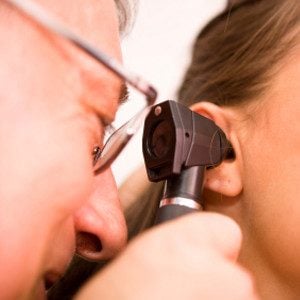Ear Pain Relief by Fighting Infection
This probably won’t soothe your frayed nerves after you’ve been up all night with a screaming child, but we’ll tell you anyway: Ear infections are extremely common, striking three out of four children at least once before age three.

They develop when the same viruses or bacteria that triggered your child’s runny nose migrate up the tube that connects the nose to the ear (most infections are actually caused by viruses). When the tube (or the adenoids at its base) swells, it traps fluid in the inner ear, causing pressure and pain and enabling an infection to fester.
Here’s the good news: Most children outgrow ear infections by age three, when the eustachian tubes become large enough and the adenoids small enough to keep infections in check.
How can you tell whether your child has an ear infection? Look for tugging at the ears, a piercing cry (especially when lying down, which intensifies the pain), and balance and hearing difficulty.
Now for the not-so-good news: Older children and adults can still get ear infections, although they’re far less common. They can be very painful and are more likely to require antibiotic treatment. If you have an ear infection, you may also have a sinus infection or a cold.
Ear Infection Relief
Most ear infections resolve on their own without antibiotics. Meanwhile, to reduce the pain, whether it’s you or your child with the ear infection, take these steps.
- Take 500 to 1,000 milligrams (follow the package directions based on your child’s age) of acetaminophen (Tylenol).
- Following the package directions, take the recommended dose of homeopathic earache tablets by Boiron, Hyland, or Source Natural every 15 minutes for the first hour and then less frequently during the first 24 hours until the pain resolves. If there is no response within 24 hours or the pain worsens, see your doctor.
- Apply a warm compress (a washcloth dipped in hot water and then wrung out, or a hot water bottle wrapped in a thin towel) to the ear.
- Blow up a balloon (don’t have a child do this unless he’s more than six).
Why It Works
The Tylenol and the warm compress ease the pain immediately, while the homeopathic ear preparations relieve pain and speed healing through a combination of ingredients.
Blowing up a balloon opens the eustachian tubes, allowing fluid to drain from the ears, speeding healing, restoring hearing, and reducing discomfort. If you’re having your child do this, however, make sure you watch carefully; children have been known to suck balloons into their windpipes.
Other Medicines
Herbs and Supplements
Otikon Otic Solution. These drops contain several antibiotic and antiviral herbs, including garlic, mullein, calendula, and St. John’s wort, in an olive oil base. Studies show this combination of herbs can work just as effectively as anesthetic ear drops to relieve pain. Before using it, however, consult your pediatrician to make sure your child’s eardrum is intact. If it’s broken, anything you put in the outer ear can go directly into the middle ear, possibly damaging the small bones that vibrate as part of the hearing process, affecting hearing.
Prescription Drugs
Antibiotics. Doctors used to prescribe antibiotics routinely to treat ear infections. Because many ear infections clear up on their own and because some are caused by viruses that don’t respond to antibiotics, however, the American Academy of Pediatrics and the American Academy of Family Physicians now recommend watchful waiting-not offering antibiotics for 2 to 3 days to see if the infection clears up on its own. If your doctor feels antibiotics are needed, he or she will probably prescribe high doses of amoxicillin, taken twice a day for 5 to 10 days. Make sure you complete the entire course, even if you start to feel better. Otherwise the germs may strike again.
Other Approaches
Allergy testing. Numerous studies have linked food allergies with an increased incidence of ear infections. In one study of 25 children with chronic ear infections, the infections improved for all but three children when their parents eliminated eggs and milk, common food allergens, from their children’s diets. When parents reintroduced these foods, the infections returned. Other common trigger foods include beans, citrus, and tomatoes. See an allergist, who can use a skin prick test or blood test to help determine whether your child has food allergies. (Skin tests for food allergies tend to work better in children than in adults.)
Ear tube surgery. If your child suffers chronic ear infections that don’t respond to antibiotics, this procedure (called myringotomy) might help. A surgeon places a small tube through an opening in your child’s eardrum, relieving pressure, restoring hearing, and allowing fluid to drain more easily. After a few months, the tubes fall out. Because the operation requires anesthesia, only consider ear tubes if fluid has remained in your child’s ears for several months, triggering recurrent ear infections and hearing difficulty.
Adenoidectomy. Surgical removal of the adenoids at the base of the eustachian tubes may help children between ages four and eight who suffer recurrent ear infections. It’s not worth considering this surgery for children younger than four, however, many of whom outgrow the infections when their adenoids shrink.
Osteopathic manipulation. An osteopathic physician can gently massage your child’s face and head, opening up ear passages and allowing fluid to drain more easily. In a study of 57 children with recurrent ear infections, osteopathic treatment significantly reduced the need for antibiotics and surgical procedures compared to children who received routine pediatric care. It also improved the health of the inner ear. Look for an osteopath who is trained in and uses the Galbreath technique, the manipulation used for ear problems.
Prevention
Breast-feed your baby. Breast milk contains protective compounds that keep bacteria in check. The sucking action also keeps your baby’s eustachian tubes open.
Vaccinate your children against the flu. In one study, the flu vaccine reduced the incidence of ear infections in children by 30 percent during flu season.
Add plums, strawberries, and raspberries to your, and your child’s, diet. These fruits contain xylitol, a natural sweetener used in many chewing gums, which, studies find, stems recurrent ear infections by preventing viruses and bacteria from migrating up the nose.
Don’t smoke around your children. Studies show that children who live in houses with smokers are more likely to have ear infections than children who live in smoke-free homes.
Try a daily teaspoon of fish oil. In a small study of eight children who suffered chronic ear infections, 1 daily teaspoon of fish oil cut the need for antibiotics by 12 percent. You can use fish oil supplements as directed for your child’s age.



